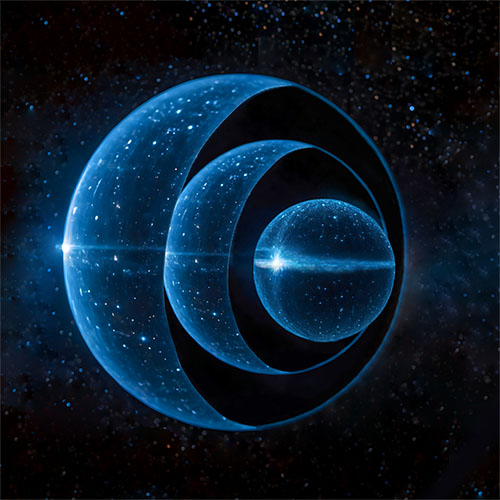| Feb 15, 2024 |
A star like a Matryoshka doll: New theory for gravastars
|
|
(Nanowerk News) The interior of black holes remains a conundrum for science. In 1916, German physicist Karl Schwarzschild outlined a solution to Albert Einstein's equations of general relativity, according to which the center of a black hole consists of a so-called singularity, a point at which space and time no longer exist. Here, the theory goes, all physical laws, including Einstein's general theory of relativity, no longer apply; the principle of causality is suspended.
|
|
This constitutes a great nuisance for science: after all, it means that no information can escape from a black hole beyond the so-called event horizon. This could be a reason why Schwarzschild's solution did not attract much attention outside the theoretical realm for a long time – that is, until the first candidate for a black hole was discovered in 1971, followed by the discovery of the black hole in the center of our Milky Way in the 2000s, and finally the first image of a black hole, captured by the Event Horizon Telescope Collaboration in 2019.
|
|
In 2001, Pawel Mazur and Emil Mottola proposed a different solution to Einstein's field equations that led to objects which they called gravitational condensate stars, or gravastars. Contrary to black holes, gravastars have several advantages from a theoretical astrophysics perspective.
|
 |
| According to findings by physicists at Goethe University Frankfurt, a gravastar could look like a matryoshka doll. (Image: Daniel Jampolski and Luciano Rezzolla, Goethe University Frankfur)
|
|
On the one hand, they are almost as compact as black holes and also exhibit a gravity at their surface that is essentially as strong as that of a black hole, hence resembling a black hole for all practical purposes.
|
|
On the other hand, gravastars do not have an event horizon, that is, a boundary from within which no information can be sent out, and their core does not contain a singularity. Instead, the center of gravastars is made up of an exotic – dark – energy that exerts a negative pressure to the enormous gravitational force compressing the star. The surface of gravastars is represented by a wafer-thin skin of ordinary matter, the thickness of which approaches zero.
|
|
Theoretical physicists Daniel Jampolski and Prof. Luciano Rezzolla of Goethe University Frankfurt have now presented a solution to the field equations of general relativity that describes the existence of a gravastar inside another gravastar. They have given this hypothetical celestial object the name "nestar" (from the English “nested”).
|
|
They report their findings in Classical Quantum Gravity ("Nested solutions of gravitational condensate stars").
|
|
Daniel Jampolski, who discovered the solution as part of his Bachelor’s thesis supervised by Luciano Rezzolla, says: “The nestar is like a matryoshka doll”, adding that, “our solution to the field equations allows for a whole series of nested gravastars.” Whereas Mazur and Mottola posit that the gravastar has a near infinite thin skin consisting of normal matter, the nestar’s matter-composed shell is somewhat thicker: “It’s a little easier to imagine that something like this could exist.”
|
|
Luciano Rezzolla, Professor of Theoretical Astrophysics at Goethe University, explains: “It’s great that even 100 years after Schwarzschild presented his first solution to Einstein’s field equations from the general theory of relativity, it’s still possible to find new solutions. It’s a bit like finding a gold coin along a path that has been explored by many others before. Unfortunately, we still have no idea how such a gravastar could be created. But even if nestars don't exist, exploring the mathematical properties of these solutions ultimately helps us to better understand black holes”.
|

